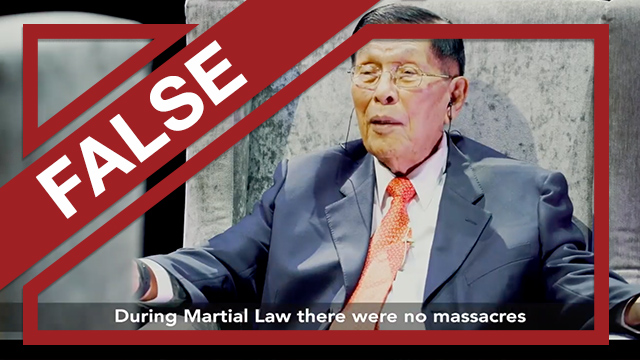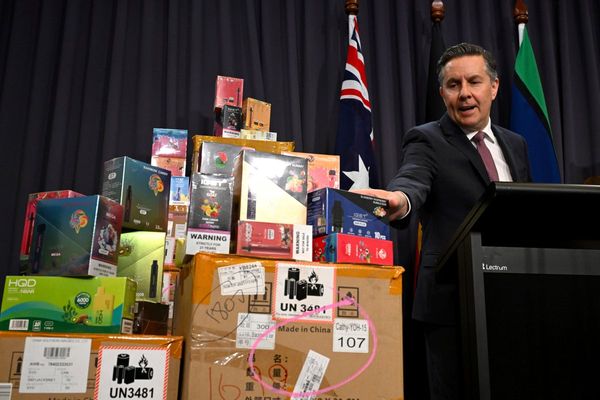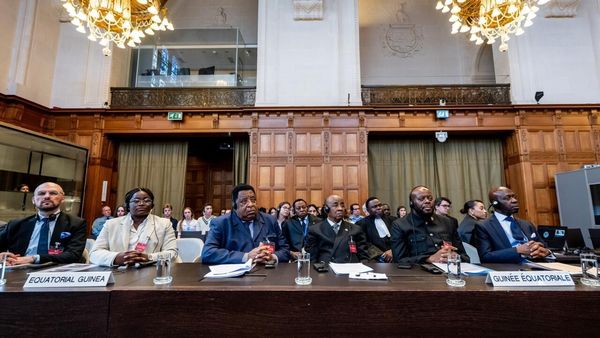
(UPDATED)
Claim: During the first part of a one-on-one talk between former senators Ferdinand "Bongbong" Marcos Jr and Juan Ponce Enrile (JPE) on Thursday, September 20, the former Martial Law administrator claimed that "no massacres" took place during that infamous period.
In that first part of "JPE: A Witness to History," Enrile said that during Martial Law, there were no massacres similar to "what happened in Mendiola during the supposed democratic government of Cory Aquino."
Bongbong is the son of dictator Ferdinand Marcos who imposed Martial Law in the Philippines during his two-decade rule. Enrile was also Marcos' defense secretary during Martial Law.
Rating: FALSE
The facts: There were at least two massacres reported between 1972 and 1981 during Martial Law. Both happened in Mindanao, and both were committed against Muslim communities.
The first was the Palimbang massacre or the Malisbong massacre in Palimbang, Sultan Kudarat. It happened on September 24, 1974 in Barangay Malisbong.
According to a 2014 report by MindaNews, the coastal village "was razed to the ground by government forces and their allies."
"Moro men were shot to death while women and children were arrested and brought to a nearby Marines and Navy boat anchored on the sea shore," said the report, quoting accounts by the Moro Women’s Center based in General Santos City.
According to the same MindaNews report, the arrested women were raped in detention. According to the Moro Women's Center's estimates, "around 1,500 male Moros aged 11 to 70 years old were massacred inside the Malisbong mosque while some 300 houses were destroyed and burned by government forces."
The Palimbang massacre was also the subject of Forbidden Memory, the winning entry of filmmaker Gutierrez Mangansakan under the Documentary Feature Category of the 2016 Cinema One Originals film festival.
Vera Files likewise wrote a report about the massacre in September 2017. It embedded a video produced by the Commission on Human Rights, which had facilitated the filing of claims by Malisbong massacre victims for reparations given to human rights victims during Martial Law. These were in accordance with Republic Act 10368.
The second massacre happened in Bingcul village in Mindanao on November 12, 1977.
This was reported by the Associated Press (AP), which was carried by many newspapers in the US and Canada on April 26, 1980, like the Arizona Republic in Arizona; the Longview News-Journal newspaper in Texas; the Albany Democrat-Herald in Oregon; and the Lethbridge Herald in Alberta, Canada.
According to the AP report, 7 uniformed armed men entered the village that night in November 1977. They ordered 12 families out of their houses, made them squat on the ground, then "opened fire, killing everyone except one adult and 3 children who, although wounded, managed to reach a cluster of bushes without being noticed." A total of 42 villagers were killed.
The armed men then "set all of the houses on fire, sparing only a hut with a kiln." It was in a pit near that hut where the victims' bodies were buried the next day in a rite led by a Muslim priest.
A director at the National Bureau of Investigation at the time, Angel Reyes, said a two-year investigation into the incident included the testimony of the 4 survivors.
Reyes said the suspects were "members of the Civilian Home Defense force, a paramilitary unit organized by the government" to help quell the rebellion in Mindanao. Reyes recommended murder charges against the 7 men.
Even after Martial Law was lifted in January 1981, there were massacres reportedly committed by government forces during the Marcos regime:
- Daet Massacre in Camarines Norte in June 1981
- Sag-od Massacre in Northern Samar in September 1981
- Escalante Massacre in Negros Occidental in September 1985
Enrile served as defense secretary until he turned against Marcos in February 1986 and joined the pro-democracy crowds that were mobilizing for what would become the People Power Revolution. – Michael Bueza/Rappler.com
Related stories:
- LIST: False claims of Juan Ponce Enrile on Martial Law
- FALSE: ‘Only one executed,’ ‘none arrested’ under Marcos’ Martial Law – Enrile
- ‘Distortion of truth’: Diokno family slams Bongbong Marcos, Enrile
- Aquino on Enrile: Old age not an excuse to bend truth about Martial Law
- ‘Repudiate’ Enrile, Marcos attempt to revise history, says Nene Pimentel
- Enrile’s claims about Martial Law ‘revolting, insanely disgusting’ – lawmakers
If you suspect a Facebook page, group, account, a website, or an article is spreading false information, let Rappler know by contacting us at factcheck@rappler.com. Let us battle disinformation one Fact Check at a time.







